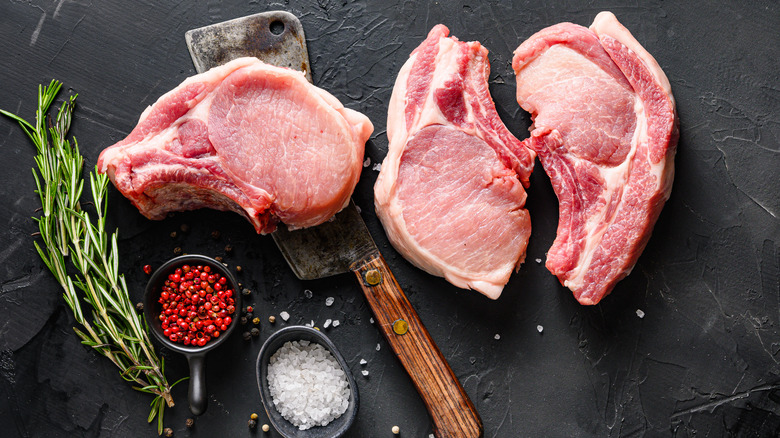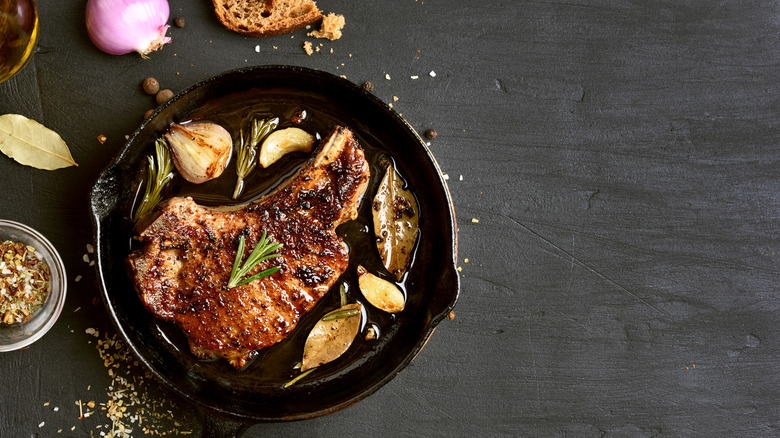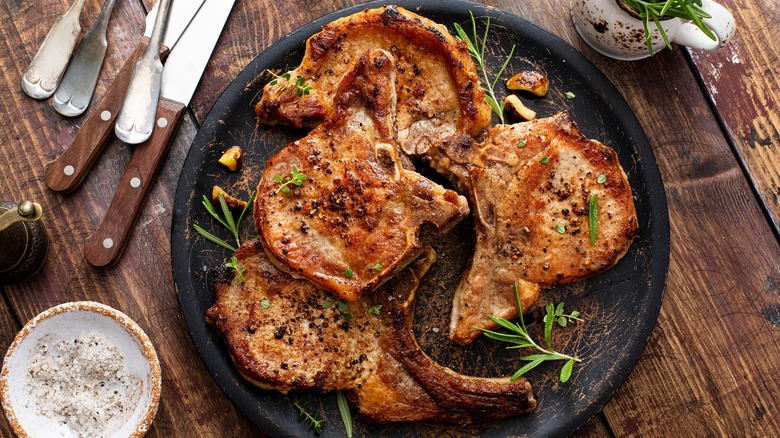The Ideal Pork Chop Thickness For Flavorful Pan-Searing
In 2011, the USDA adjusted its recommended internal temperature for cooked pork from 160 degrees Fahrenheit to 145 degrees Fahrenheit. That means it's probably safe to say that more than a few of us have had a dried out, overcooked pork chop or two. However, temperature isn't the only factor related to making the perfect pork chop. There are lots of tricks for preparing juicy pork, but one of the crucial keys to cooking up a top notch pork chop is picking one with just the right thickness. Choosing one that's too thin can result in a dry chop, while thicker cuts can be risky on the stovetop, sometimes cooking unevenly, according to The Washington Post.
Thin cut pork chops are usually about ½ inch thick or less, while thick chops are 1 ½ inch thick. For the best pan-seared pork chop you'll want to aim for one that's in between, clocking in at just 1 inch thick. Pan-searing a 1-inch thick pork chop gives you the ability to get a quality crust on the outside, while the meat cooks through.
Why pan-sear a 1-inch thick pork chop
Thinner pork chops cook too quickly to get delicious caramelization on the outside, while thicker cuts can get too crispy while you wait for the meat to reach the desired internal temperature. And since your pork is cooking on the stove top, it's easily accessible for checking the temperature with a thermometer. Another advantage to pan-searing is that you can add seasoning to the pork in the pan.
Gordon Ramsay recommends seasoning the pork both before cooking and while cooking to get the best results. He also continuously bastes the pork with the oil in the pan, further preventing the pork chop from drying out. One more benefit to pan-searing is that once the pork chop is removed to rest, you can quickly create a sauce using the drippings from the cooked pork. Or, instead of sauce, you can saute vegetables to have on the side.
Other tips for preparing perfect pan-seared pork chops
The thickness of the pork chop is one of the most important considerations that contributes to the end result of pan-seared pork. But there are a few other tricks to try to achieve the most juicy and flavorful pork chops. As with any meat, allowing it to come to room temperature prior to preparing it is key. It doesn't take long, and the end result is meat that is cooked more uniformly throughout. It takes less time to cook, too.
Some also suggest brining pork chops to ensure that they come out moist and full of flavor. However, while this simple technique can potentially transform chops into incredibly moist pieces of meat, it can inhibit the formation of a crisp crust. Finally, just as you would with other meats like steak or turkey, allow the meat to rest after it's been cooked. Giving the pork time to rest after cooking reduces the amount of moisture lost when slicing, further ensuring that your pork chops will be juicy and full of flavor.


